Transmission Torrent Client For Mac
Posted By admin On 18.01.19Here’s news for those interested in internet security, news about malware and Mac-based malware. This is also news for those who believe that fighting Mac virus is not just being armed with an.
It’s basically the knowledge gained about malware and their functionality that counts Transmission, the very popular BitTorrent client, has been found distributing a Mac-based malware. This comes just a few months after it was used by malware authors to transmit the KeRanger. It was early in March that the Transmission BitTorrent client installer for OS X was found infected with ransomware, which was named KeRanger. Now, almost six months later, security experts at cyber-security firm Eset have discovered another malware in Transmission.

This, which was discovered earlier and named OSX/Keydnap, was supposed to spread “through attachments in spam messages, downloads from untrusted websites”. But now, Eset experts have found it in Transmission too. In the ‘We Live Security blog’, which features, news, views etc from Eset experts, a post dated August 30 explains this in detail. Aws cli client for mac os.
Torrent Client For Mac Osx

Osx Torrent Client
The post begins as – “Last month ESET researchers wrote an article about a new OS X malware called OSX/Keydnap, built to steal the content of OS X’s keychain and maintain a permanent backdoor. At that time of the analysis, it was unclear how victims were exposed to OSX/Keydnap. To quote the original article: “It could be through attachments in spam messages, downloads from untrusted websites or something else.”During the last hours, OSX/Keydnap was distributed on a trusted website, which turned out to be “something else”. It spread via a recompiled version of the otherwise legitimate open source BitTorrent client application Transmission and distributed on their official website.” The post also says that the Transmission team removed the malicious file from their web server literally minutes after they were informed by Eset, and an investigation to detect how this happened has been launched. The We Live Security Blog post further says- “At the time of writing, it was impossible to tell exactly when the malicious file was made available for download. According to the signature, the application bundle was signed on August 28th, 2016, but it seems to have been distributed only the next day.